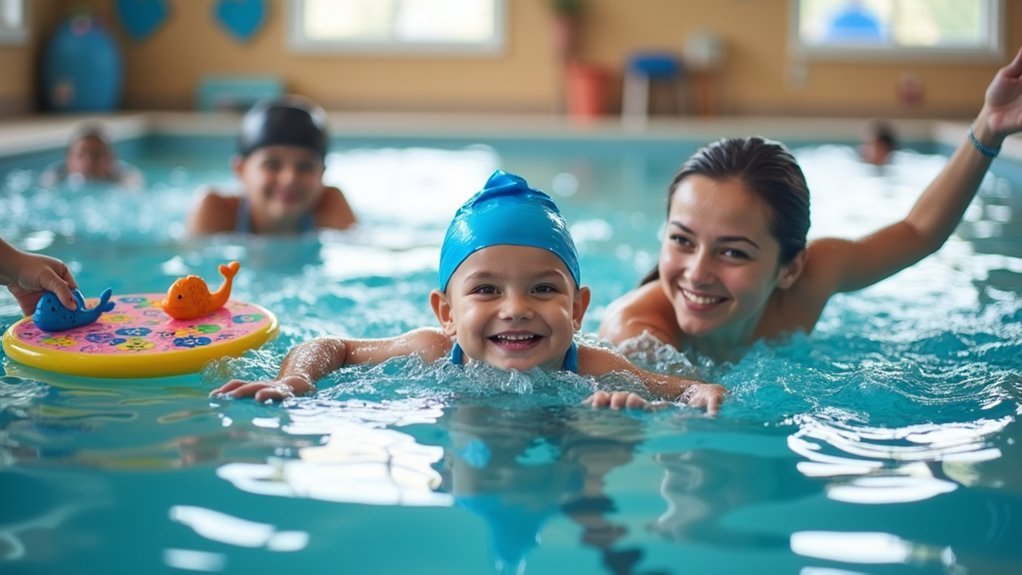Therapeutic swimming for Down syndrome offers five effective approaches: buoyancy-based core strengthening to improve stability, proprioceptive water activities to enhance balance, adaptive swimming techniques for better motor planning, sensory integration games for processing development, and progressive water safety skills through play. You’ll find these water-based therapies reduce joint stress while improving coordination, strength, and confidence. Discover how these specialized aquatic activities can transform physical development while creating an enjoyable, supportive environment.
Buoyancy-Based Core Strengthening Exercises

When individuals with Down syndrome enter the water, they immediately benefit from the unique properties of aquatic environments. The buoyancy reduces joint stress, making exercises ideal for those with low muscle tone and ligamentous laxity common in Down syndrome.
You’ll find that water resistance naturally encourages core engagement, enhancing trunk stability and oblique activation without excessive joint strain. Core stability exercises in water strengthen posture and balance while dynamic movements improve neuromuscular coordination.
Water naturally activates core muscles, creating strength and stability while protecting joints—the perfect exercise environment for Down syndrome individuals.
For best results, include trunk rotation exercises that specifically target oblique muscles. Implement these exercises in supervised sessions three times weekly for maximum benefits.
The multisensory experience of water also supports sensory integration, addressing processing issues while simultaneously building strength—a therapeutic advantage that’s difficult to replicate in land-based activities. This approach is particularly valuable for the 18% of children with Down Syndrome who have a dual diagnosis of Autism, providing beneficial sensory input in a controlled environment.
Proprioceptive Water Activities for Balance and Coordination
Building on the core strength foundation, we now explore how water’s unique properties enhance proprioceptive awareness for individuals with Down syndrome. The resistance and drag of water naturally amplify body awareness, making it easier to sense movement and position.
You’ll find walking exercises particularly beneficial—try assisted pool walking or climbing pool stairs to improve coordination while protecting joints.
Use pool noodles for support during balance activities, gradually reducing assistance as confidence grows.
“Blast off” exercises from the pool edge strengthen lower extremities while enhancing coordination.
For more advanced practice, incorporate movement through varying water depths to optimize hydrostatic pressure and challenge postural control.
The combination of water’s tactile input and resistance creates an ideal environment for developing spatial awareness and motor planning skills that transfer to daily living activities. Aquatic therapy utilizes the natural properties of water buoyancy and resistance to facilitate motor skill development while providing an enjoyable therapeutic environment.
Adaptive Swimming Techniques for Motor Planning

Motor planning challenges present a significant hurdle for individuals with Down syndrome learning to swim. You’ll need to implement specialized techniques that break down complex movements into manageable components.
Swimming strokes require intricate coordination of breathing and simultaneous limb movements, which can be particularly difficult to master.
- Use visual demonstrations followed by hands-on guidance to help swimmers imitate proper form
- Focus on mastering one skill completely before introducing the next element
- Incorporate repetitive practice sessions with consistent feedback
- Implement periodized training to gradually increase complexity and performance
- Use the water’s natural resistance to develop proprioceptive awareness and muscle memory
Research shows that children with Down syndrome typically require more time to learn swimming techniques due to their unique developmental considerations. These adaptive techniques accommodate learning differences while building the motor planning abilities necessary for swimming proficiency, laying groundwork for both recreational and competitive swimming success.
Sensory Integration Games in the Aquatic Environment
Sensory integration games create powerful learning opportunities in the aquatic environment for individuals with Down syndrome. Water’s unique properties provide rich tactile and vestibular inputs that enhance body awareness through proprioceptive feedback.
You’ll find that activities like exploring different water textures and temperatures help regulate sensory processing effectively.
Try incorporating brightly colored, textured pool toys to engage multiple senses simultaneously. Games involving gentle water movements can create a calming atmosphere, reducing anxiety while promoting relaxation.
When planning these activities, consider using dimmable lights and quiet areas for sensory breaks when needed.
These games not only improve sensory regulation and self-control but also help integrate primitive reflexes, enhancing coordination and motor skills in a low-impact, joint-friendly environment. Aquatic therapy addresses muscle tone issues commonly associated with Down syndrome through buoyancy-assisted movements.
Progressive Water Safety Skills Through Play

While developing water safety skills is critical for all children, it’s especially essential for individuals with Down syndrome who face more than twice the risk of drowning compared to their neurotypical peers.
Water safety isn’t just important—it’s vital for children with Down syndrome, who face dramatically higher drowning risks.
You can incorporate safety skills into playful activities that build competence through repetition and enjoyable practice.
- Transform breath control exercises into bubble-blowing contests, gradually increasing underwater duration.
- Use colorful toys that sink to encourage safe water entry, submersion, and retrieval skills.
- Practice safe pool entry/exit repeatedly through “follow the leader” games.
- Create obstacle courses that require moving along the wall and practicing reaching for safety.
- Introduce floating skills as “superhero poses” with verbal cues that can be consistently repeated.
Each playful activity builds critical safety skills while accommodating sensory sensitivities and promoting mastery through repetition. Research shows that children with Down syndrome, who represented 34.8% of participants in the iCan Swim program, can make significant progress with consistent, structured instruction.
Frequently Asked Questions
At What Age Should Children With Down Syndrome Start Aquatic Therapy?
You can start your child with Down syndrome in aquatic therapy as early as six months if they have good neck control. Most programs focus on children between 6 months and 4 years for ideal developmental benefits.
How Do Pool Temperature and Environment Affect Therapy Outcomes?
Warmer pools (90-94°F) enhance your child’s comfort and muscle relaxation, while a supportive environment with easy access features improves engagement. You’ll see better outcomes when the setting accommodates their sensory and physical needs.
Can Aquatic Therapy Help Reduce Hypotonia in Down Syndrome?
Yes, aquatic therapy can help reduce hypotonia in Down syndrome. You’ll find that water’s buoyancy supports your child’s body while providing resistance that strengthens their muscles, effectively addressing low muscle tone over time.
How Does Aquatic Therapy Complement Land-Based Physical Therapy?
Aquatic therapy complements land-based PT by providing buoyancy that reduces joint stress while you’re strengthening muscles. You’ll benefit from water resistance for conditioning and enjoy increased motivation in a soothing environment that enhances overall recovery.
What Certifications Should Instructors Have for Down Syndrome Aquatic Programs?
You’ll want instructors with Adapted Aquatics Instructor Credentials and training from programs like Swim Whisperers®. Look for those with experience in disability management, seizure protocols, and ideally occupational or physical therapy backgrounds.
In Summary
You’ve now explored five powerful swim activities tailored for individuals with Down syndrome. Through water’s natural properties, you’ll strengthen core muscles, improve balance, enhance motor planning, address sensory needs, and build essential safety skills. Remember, consistency is key—each session builds confidence and ability. As you implement these therapeutic approaches, you’ll witness meaningful progress that extends beyond the pool into everyday life.





Leave a Reply